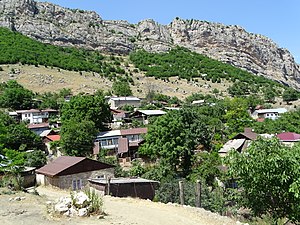| Dashalty / Karin Tak Daşaltı / Քարին Տակ | |
|---|---|
 Village in June 2015 Village in June 2015 | |
 | |
| Coordinates: 39°44′30″N 46°44′57″E / 39.74167°N 46.74917°E / 39.74167; 46.74917 | |
| Country | |
| District | Shusha |
| Population | |
| • Total | 660 |
| Time zone | UTC+4 (AZT) |
Dashalty (Azerbaijani: Daşaltı) or Karin Tak (Armenian: Քարին Տակ) is a village in the Shusha District of Azerbaijan, in the region of Nagorno-Karabakh. Until 2020, the village was controlled by the Republic of Artsakh. The village had an ethnic Armenian-majority population prior to the 2020 Nagorno-Karabakh war, and also had an Armenian majority in 1989.
About 3 km downriver there is a mossy waterfall named "Zontik" (Russian: Зонтик, literally, "Umbrella"), because of its resemblance to an umbrella in the rain. The village is an overnight stopping point along the Janapar hiking trail.
As of 2024, the entire village of Karin Tak has been razed to the ground by Azerbaijan.
Etymology
Both the Azerbaijani and Armenian names of the village mean "below the rock", referring to the sheer vertical cliffs towering above the village, on top of which Shusha is built.
History
During the Soviet period, the village was part of the Shusha District of the Nagorno-Karabakh Autonomous Oblast. After the First Nagorno-Karabakh War, the village was administrated as part of the Shushi Province of the breakaway Republic of Artsakh. Shusha, located just above the village, was the last Azerbaijani stronghold in Nagorno-Karabakh to be captured by Armenian forces in the First Nagorno-Karabakh War. On January 26, 1992 Azerbaijani Defense Minister Mehdiyev "led a disastrous sortie out of Shusha to capture the Armenian village of Karintak", in which dozens of Azerbaijani soldiers died.
On 9 November 2020, the last day of the 2020 Nagorno-Karabakh war, Azerbaijani troops captured the village, and after that, the city of Shusha itself.
The village monument dedicated to the fallen in World War II was destroyed by Azerbaijani forces after the 2020 Nagorno-Karabakh war.
Destruction of the village
On April 5, 2024, Google Earth updated satellite images of the Nagorno Karabakh. The Monument Watch team documented that Azerbaijan razed the village to the ground, including its old neighborhoods, springs, civil infrastructure and natural environment.
Historical heritage sites
Historical heritage sites in and around the village include a 13th-century khachkar, an 18th/19th-century cemetery, an 18th/19th-century bridge, a 19th-century watermill, and the church of Surb Astvatsatsin (Armenian: Սուրբ Աստվածածին, lit. 'Holy Mother of God') built in 1862.
The old town square is relatively well preserved, showing some traditional pre-Soviet architecture of the region. There is also a plain village church that was restored by Land and Culture Organization volunteers in 1999–2000. It was originally built in 1816 in the place of a previously existing chapel.
Demographics
The village had 588 inhabitants in 2005, and 660 inhabitants in 2015.
Gallery
-
 Village street
Village street
-
 Monument dedicated to the fallen in WWII and the First Nagorno-Karabakh War
Monument dedicated to the fallen in WWII and the First Nagorno-Karabakh War
-
 The church of Surb Astvatsatsin, built in 1862
The church of Surb Astvatsatsin, built in 1862
-
 "Zontik" (Umbrella) waterfall in the Karkar Canyon
"Zontik" (Umbrella) waterfall in the Karkar Canyon
-
 Karkar river canyon
Karkar river canyon
-
Section of the Janapar hiking trail passing by the village
-
 Destroyed military vehicle
Destroyed military vehicle
-
 General view
General view
References
- ^ Hakob Ghahramanyan. "Directory of socio-economic characteristics of NKR administrative-territorial units (2015)".
- Андрей Зубов. "Андрей Зубов. Карабах: Мир и Война". drugoivzgliad.com.
- ""New reports emerge of damage to Armenian heritage in Karabakh"". civilnet.am.
- Carey Goldberg (1992-05-10). "Armenians Capture Key Karabakh Town : Republics: Both sides agree the fall of the last Azerbaijani stronghold marks a turning point in the four-year struggle over the disputed enclave". Los Angeles Times. Retrieved 2011-09-27.
- Black Garden, Thomas de Waal, page 176
- Black Garden, Thomas de Waal, page 292
- "Azərbaycan Respublikası Müdafiə Nazirliyi".
- "Russian MFA considers vandalism against monuments to heroes of Great Patriotic War in Artsakh by Azerbaijanis unacceptable and immoral". aysor.am. 2021-03-12.
- "Complete destruction of the village of Karintak by Azerbaijan". Monument Watch.
- "Azerbaijan's Destruction of Armenian Heritage in Artsakh Continues Unabated". Hyperallergic.
- "Azerbaijan Destroys Armenian Church and Village, Builds Mosque in Conquered Artsakh". Christian Persecution News Persecuted Christians.
- Amos Chapple. "Church, Entire Village 'Erased' In Azerbaijan's Recaptured Nagorno-Karabakh". Radio Free Europe.
- Mkrtchyan, Shahen. Historical-Architectural Monuments of Nagorno Karabagh. Yerevan, 1989. (Շահեն Մկրտչյան, «Լեռնային Ղարաբաղի պատմաճարտարապետական հուշարձանները»)
- "The Results of the 2005 Census of the Nagorno-Karabakh Republic" (PDF). National Statistic Service of the Republic of Artsakh.
External links
| Shushi Province | ||
|---|---|---|
| Rural communities |  | |
| Not under Artsakh control | ||
